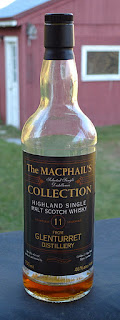stats: single malt scotch, Central Highlands, 92 proof, $60
As I gaze across my collection of whisky bottles, queued up and waiting to blogged about, I notice that there are several from independent bottlers. In my early days as a whisky consumer I viewed independent bottlings with a suspicious eye, assuming that they came from inferior casks which the distilleries had unloaded on little companies that didn’t produce any whisky, to be sold at discounted prices. While my old assumption may hold true at times, it would very much be the exception rather than the rule.
By the simplest definition, an independent bottler is someone who buys casks of whisky from distilleries (and possibly ages it for some additional time), then bottles and sells it themselves. This is a phenomenon that is fairly, though not completely, unique to Scotland. In the United States, contract distilling is much more common – a situation where one has a whiskey company but no facilities, and hires a distillery to make their product from start to finish. In this case the client would specify the details of production throughout the process.
Modern independents represent a vast array of business models. Some of the largest firms have a connection to a distillery, with Gordon & MacPhail acquiring and resurrecting the defunct Benromach in 2002, and the owners of Springbank distillery purchasing Cadenhead in 1972. At the opposite end of the spectrum there are companies like James MacArthur and Deerstalker, which essentially operate as one-man-bands. Between these extremes there are many mid sized independents, such as Signatory, Hart Brothers, and Murray MacDavid. Some independent bottlers have their own warehouses and/or bottling lines, others may pay a fee to keep their casks in someone else’s warehouse and contract out the bottling process.
In spite of these differences, they all have a common origin. In the late 1700’s and early 1800’s, malt whisky in Scotland was primarily sold by distillers in bulk (usually in barrels) to grocers and wine merchants, who sold it on to consumers. Around 1830, the column still was invented and grain whisky became a cheap alternative. By 1860, many of the whisky merchants began blending malt and grain whisky. Several of these brands grew in size and popularity, and live on to be a common sight on store shelves today. But some merchants stuck with malt whisky, and they are the ancestors of the modern independent bottlers. Currently, most malt whisky produced in Scotland (upwards of 90%) is sold in bulk to blenders. That was even more true 50 to 60 years ago, before the malt distilling companies began to tap into the unexploited market for single malts. For many decades, independent bottlers were the only source of single malt from most distilleries. That has changed over the years since WWII, but even today a few distilleries do not market an official single malt bottling.
So the independent bottlers are buying in bulk alongside the blenders, just at a much smaller volume. In times of low demand, they occasionally have the opportunity to buy excess stock from the blenders as well.
Aside from offering single malts from distilleries who do not market their own, what do independent bottlers do to differentiate themselves? Well, there are distilleries that offer an official bottling, but with minimal production levels and limited distribution. The independents add greatly to the availability of these more obscure brands.
They also frequently offer single cask bottlings. Distillers strive for consistency from bottle to bottle in their official releases, so they typically marry together several hundred barrels to come up with a vatting that is uniform in flavor from batch to batch. Independents don’t have to do that, and they will often seek out odd barrels – of fine quality, just deviating from the standard house flavor profile – and bottle them individually to produce a unique product. Distiller bottled single malts typically end up being bottled between 80 (the legal minimum) and 86 proof. Independently bottled single malts often end up at a higher proof, from 92 right up to undiluted cask strength. The independents also have the flexibility to bottle their whiskies with a greater variety of age statements than their distilling counterparts do. Additionally, since they offer their products to a niche market, they see smaller swings in demand levels, and are often able to bring older whiskies to market at much more attractive pricing levels than the distilleries can.
There are also two practices that are far less common in independent bottlings – artificial coloring and chill-filtering. It is legal to add caramel coloring to scotch, but the practice is frowned upon by critics. It is usually done to give consistent color from batch to batch, but can be detrimental to the flavor. When whisky gets cold (by adding ice, or any other way), it gets cloudy. The compounds that cause this haze can be stripped out by chilling and filtering the whisky – chill-filtering. Sadly, much flavor gets stripped out at the same time. The industry as a whole is slowly moving away from these practices due to media criticism and the demands of increasingly savvy consumers. Still, these practices are far less common amongst independent bottlers.
The independents have a few other tricks up their collective sleeve, but I’ll save the details on those for some reviews that will be following in the coming weeks.
And now on to the 11 year Glenturret from Gordon & MacPhail.
Dark amber to medium brown in color. A rich, malty nose, with very little in the way of sweetness or fruitiness. Dense and chewy. Like a liquid desert (in flavor, but not with sweetness), with notes of toffee, caramel and cocoa powder / unsweetened chocolate, possibly balanced by a hint of cinnamon. The finish is relatively long and dry. Quite unique, unlike any other single malt I’ve tasted. I’m curious to know how this compares to the official distillery bottling.





















